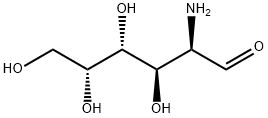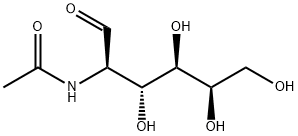PRODUCT Properties
| Melting point: | 185 °C |
| Boiling point: | 532.5±50.0 °C(Predicted) |
| Density | 1.491±0.06 g/cm3(Predicted) |
| storage temp. | under inert gas (nitrogen or Argon) at 2–8 °C |
| solubility | Soluble (water), slightly soluble (ethanol) |
| pka | 11.21±0.45(Predicted) |
| optical activity | Alpha form +124 → +93 Beta form +47 → +93 |
Description and Uses
Galactosamine is a model hepatotoxicant, induces hepatitis
characterized by neutrophilic infiltration, and kills the animal
by fulminant hepatic failure. Galactosamine, an amino derivative
of sugar galactose, has been used as a model hepatotoxicant
since the first reports of hepatotoxicity in late 1970s by
Keppler and associates. Galactosamine-induced hepatitis has
been a model of choice to study various aspects of liver disease,
including mechanisms of toxicant-induced apoptosis and
necrosis, liver tissue repair, neutrophil infiltration and transmigration,
and the role of endotoxin or lipopolysaccharide
(LPS) in initiating liver injury.
Humans and animals synthesize galactosamine in the body.
Galactosamine (a type of hexosamine) is formed when an
amino group replaces one of the hydroxy groups of a sixcarbon
sugar, or hexose. The human body utilizes uridine
diphosphate (UDP)-N-acetyl-D-glucosamine or glucosamine as
a precursor to synthesize this compound, and is most often
found in the form N-acetyl-D-galactosamine (often referred to
as N-acetylgalactosamine). Most importantly, galactosamine is
a constituent of hyaluronic acid, a powerful water-binding
agent. Many different types of tissues in human body contain
hyaluronic acid, which acts as a lubricating agent in the synovial
fluid of joints and in connective tissues. Hyaluronic acid
also acts as a lubricating agent in the vitreous humor of the
eyeball. Hyaluronic acid has considerable medicinal value; it is
often used in wound healing, burn dressings, osteoarthritis
treatment, cataract or corneal transplantation surgery, and
various types of plastic surgeries.
Safety
| Symbol(GHS) |  GHS07 |
| Signal word | Warning |
| Hazard statements | H317-H319 |
| Precautionary statements | P280-P305+P351+P338 |




